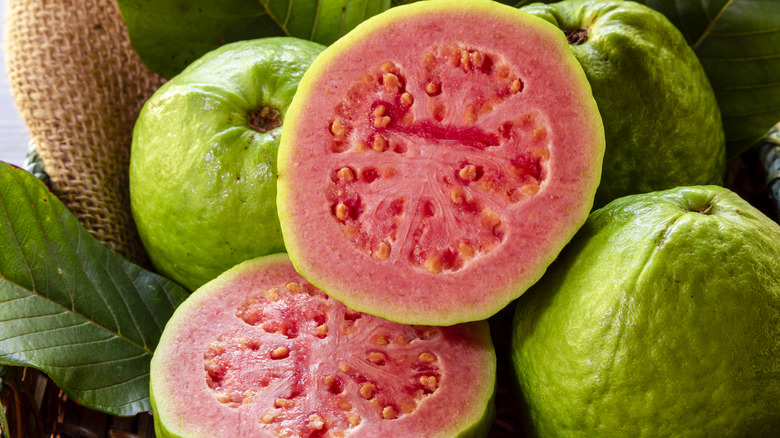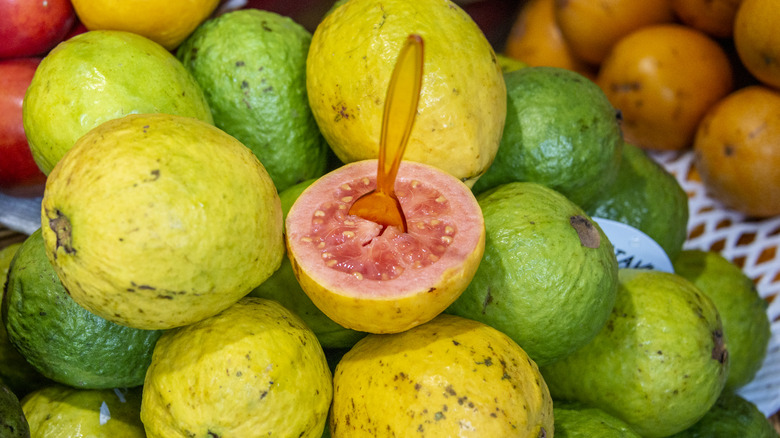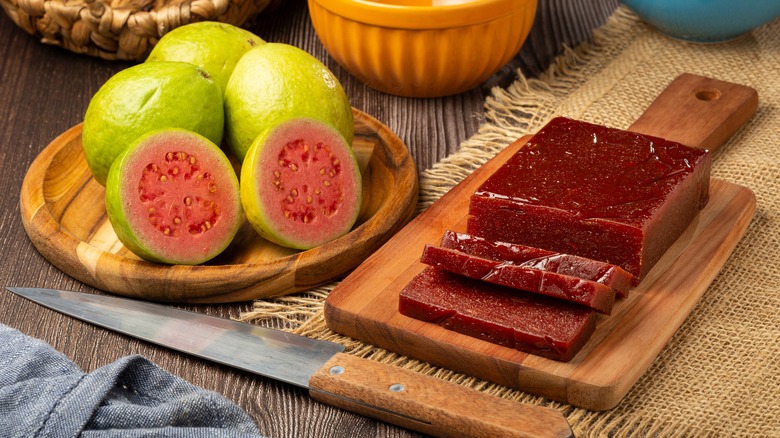The Secret To Ripening Guava In A Flash
Ripe guavas are one tropical fruit worth seeking out. They have mouthwatering juicy flesh that bursts with sweet and tart flavors, often described as a combo of strawberry and pear. The one caveat is that guavas need some time to arrive at this delicious stage. They naturally ripen when left out at room temperature, with underripe fruits reaching their prime within five days to a week. But if that seems like too long a wait, all you have to do is pop the fruits into a brown paper bag with an apple or a banana — the same method you would use to ripen avocados faster.
Apples, bananas, and many other fruits and veggies emanate ethene gas (also commonly known as ethylene). This gas breaks down the cells in ethene-sensitive produce and causes it to ripen even after being picked. Not all fruits age upon exposure to ethene (oranges, for instance, are not sensitive to it), but guavas certainly do. Storing them in a bag with ethene-emitting fruits can hasten the maturation process, though you'll want to check on the guavas frequently, as the gas can quickly cause rotting if you go overboard.
Another thing to bear in mind is that guavas are often coated in a shiny layer of edible wax, which can slow down the ripening process, as well. If you want to enjoy them ASAP, wash the fruits thoroughly to get rid of the wax before putting them in the bag.
How to pick the ripest guavas
While the paper bag tip will deliver ripe guavas in a faster way, you can avoid the hassle by choosing mature ones at the store that are ready for eating. One of the most obvious indicators of a guava's ripeness is the color of its skin. Guavas come in all kinds of shades, depending on the cultivar, but it's best to steer clear of bright green ones. The common tropical pink guavas have sunny yellow to yellow-green rinds, while Mexican cream guavas have white exteriors and Malaysian reds are scarlet. The common denominator is that any vivid or deep green tint on the outside indicates underripe fruit.
The next test is to pick up the guava and gently feel its exterior. Unripe guava will feel firm under your fingers, whereas a ripe one will feel softer when lightly pressed. That said, you don't want it to be mushy or squishy — these are signs of an overripe guava that is on its way to spoilage.
You can always give the fruit a quick whiff, too. Unripe guavas will have no noticeable smell, but ripe ones will have a sweet and musky aroma. On the flip side, a pungent, fermented, or vinegary odor is an indicator that the guava is past its prime.
How to use up ripe guavas
There is a fine line between a ripe guava and an overripe one, so make sure to eat the fruit quickly once it's at the right stage. If you're not familiar with how to eat or cook with them, you can enjoy the raw fruit as-is — skin, seeds, and all. If you'd rather chop it up, whether for use in recipes or just as a snack, you can cut it in half and scoop out the juicy flesh, as you would with an avocado.
Guavas can be used in both sweet and savory dishes. The high pectin in the fruit makes it well-suited for jams and jellies, which you can use in Brazilian guava jelly rolls. These gems also make for unique cookies and cheesecakes, are a fabulous addition to cheese boards, and their sweet brightness makes them a great garnish for rich meats. You could also crack open a guava for staggeringly refreshing mojitos, or blend the flesh into smoothies. For a sweet-spicy snack, toss the chopped fruit in a mixture of chili powder, salt, and lime zest.
If you're not ready to use all up your guavas just yet, pop them in the refrigerator, where they will keep for up to four days. Alternatively, you could chop or puree the flesh and freeze it. It should maintain peak quality for up to a year.



